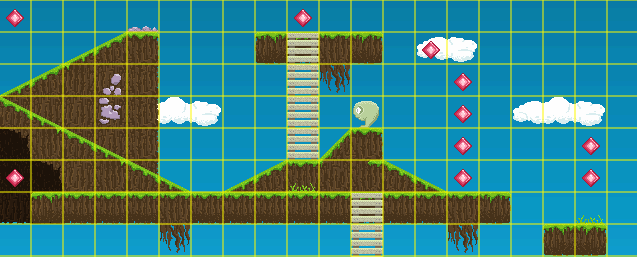Tilemap Concepts
Let’s start from a purely conceptual level, with some diagrams using tile assets created by Eris available from OpenGameArt. A tile map could be thought of as a grid of tiles, as demonstrated in this image:
Along with the map is the tile set, which defines the individual tiles that can be used within the map, i.e.:
We assign a number to each tile in the tile set:
We can then specify what tile fills a grid cell in the tile map with the same number, i.e.:
You can see that a relatively complex map can be quickly assembled from a relative handful of tiles. Looking at the image above, you may naturally consider a 2-dimensional array:
int map = new int[,]
{
{-1,-1,-1,-1,46,-1,-1,-1,-1,-1,-1,-1,-1,-1,-1,-1,-1,-1,-1,-1},
{-1,-1,52,53, 1,-1,-1,-1, 3,45, 1, 3,-1,37,38,-1,-1,-1,-1,-1},
{52,53,57,47, 4,-1,-1,-1,-1,44,23,-1,-1,-1,-1,-1,-1,-1,-1,-1},
{24,25, 4,48, 4,40,38,-1,-1,44,-1,-1,-1,-1,-1,-1,37,40,38,-1}
{12,57,24,25, 4,-1,-1,-1,-1,44,56, 1,-1,-1,-1,-1,-1,-1,-1,-1},
{-1,12, 4,29,30,25,-1,52,53, 0,61, 7,39,25,-1,-1,-1,-1,-1,-1},
{-1,62, 1, 1, 1, 1, 1, 1, 1, 1, 1,45, 1, 1, 1,62,-1,-1,28,-1},
{-1,-1,-1,-1,-1,23,-1,-1,-1,-1,-1,44,-1,-1,23,-1,-1, 2,62,-1}
}And to draw the map, we would iterate over this array, drawing the corresponding tile from the tileset:
for(int x = 0; x < map.GetLength(0); x++)
{
for(int y = 0; y < map.GetLength(1); y++)
{
int tileIndex = map[x,y];
if(tileIndex == -1) continue; // -1 indicates no tile, so skip drawing
DrawTile(x, y, tileIndex);
}
}So you can see we need to implement classes corresponding to 1) the set of available tiles, and 2) the tile map, which is really just a collection of indices for the tile set. But before we do that, we need to discuss 2d and 1d arrays in a bit more detail.



